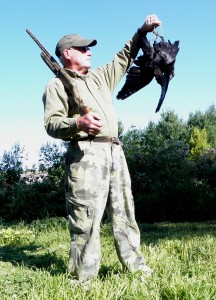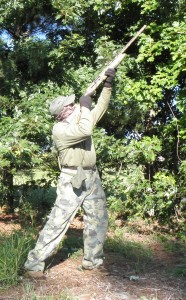By Glen Wunderlich
Before the internet days, most of our information came from the printed word in the form of newspapers, magazines, and books. Back in the ‘80s, a friend, Don, introduced me to The Varmint and Crow Hunter’s Bible by one Bert Popowski (1962) – a 185-page collection of black and white photos, drawings and expert advice on varmint hunting strategy. I was able to borrow the book and gobbled up and digested as much as possible about crow hunting, in particular.
So exciting were the revelations to me, that I shared some of the wisdom with a work associate and let him take the book home to review. That’s the last time I ever set eyes upon the how-to reference manual. And, when it came time to break the news of the book’s disappearance to Don, I could sense the disappointment; he cherished the book, as well.
Many years later, I was able to obtain a copy of the book from ebay and decided to wrap it up as a Christmas gift for Don. I’ll never forget the look on his face when he exclaimed that the “present” was the best gift he had ever received. As I’m sure anyone will understand – given the circumstances of my generous giving – I sure couldn’t ask to borrow the book again, so I found a copy for myself and have held it closely ever since. (By the way, the book is available in used format yet today on sites such as Amazon for a couple of bucks!)
Ol’ Bert was knocking down crows by the hundreds on a good day and tallied some 80,000 to 100,000 crows in his lifetime. And, he did it without aid of electronic calls and battery-operated decoys. He mastered the myriad crow calls and enticed them within close range through mouth-blown calls in a day when there was no closed season or limit on the number that could be taken.
Crows have since been protected by the Migratory Bird Treaty Act of 1975 – a federal act resulting from a formal treaty signed by the United States, Canada, and Mexico. However, under this act, crows may be controlled without a federal permit when found “committing or about to commit depredations upon ornamental or shade trees, agricultural crops, livestock, or wildlife, or when concentrated in such numbers and manner to constitute a health hazard or other nuisance.” In addition, states are permitted to regulate crow hunting through established seasons of no more than 120 days per year; Michigan’s seasons are August through September and February through March.
One question frequently asked is why one would hunt crows. I can honestly say that I’ve never eaten crow voluntarily – only figuratively. However, when it comes to crows – those critters that spread diseases, destroy agricultural crops, and kill baby song birds and eat the eggs of game birds – it’s not about what I eat; rather, it’s about what they eat and destroy.
Recently, I watched helplessly, as a lone crow robbed the nest of robins and flew off with a newly hatched baby bird. All the neighboring birds could do was scream bloody murder. All I can do is to fight back with my shotgun.
No doubt, few will measure up to the likes of Bert Popowski, but in our own way, we can even the score incrementally, while honing our wing shooting in the “off season” that’s now in. For those in states other than Michigan, make sure to check your regulations.





 “Duck stamps were one of the key funding mechanisms that brought many waterfowl species from vanishing to flourishing. Other bird, mammal, reptile and amphibian species benefitted, too,” said the Club’s Keith Balfourd. “This should be a point of pride for all hunters. It certainly is for Boone and Crockett, whose members played an important part in the history of North American waterfowl, including the duck stamp.”
“Duck stamps were one of the key funding mechanisms that brought many waterfowl species from vanishing to flourishing. Other bird, mammal, reptile and amphibian species benefitted, too,” said the Club’s Keith Balfourd. “This should be a point of pride for all hunters. It certainly is for Boone and Crockett, whose members played an important part in the history of North American waterfowl, including the duck stamp.”